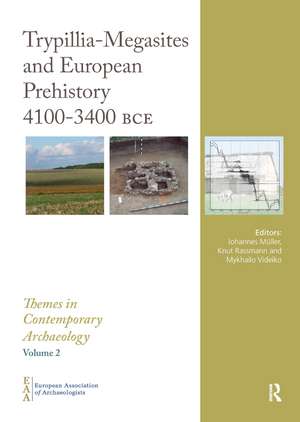Trypillia Mega-Sites and European Prehistory: 4100-3400 BCE: Themes in Contemporary Archaeology
Editat de Johannes Müller, Knut Rassmann, Mykhailo Videikoen Limba Engleză Paperback – 12 dec 2019
Since then many questions arose which are of main relevance: Why, how and under which environmental conditions did Trypillia mega-sites develop? How long did they last? Were social and/or ecological reasons responsible for this social experiment? Are Trypillia and the similar sized settlement of Uruk two different concepts of social behaviour?
Paradigm change in fieldwork and excavation strategies enabled research teams during the last decade to analyse the mega-sites in their spatial and social complexity. High precision geophysics, target excavations and a new design of systematic field strategies deliver empirical data representative for the large sites. Archaeological research contributed immensely to aspects of anthropogenic induced steppe development and subsistence concepts that did not reach the carrying capacities. Probabilistic models based on 14C-dates made the contemporaneity of the mega-site house structures most probable.
In consequence, Trypillia mega-sites are an independent European phenomenon that contrasts both concepts of urbanism and social stratification that is seen with similar demographic figures in Mesopotamia. The new Trypillia research can be read as the methodological progress in European archaeology.
Preț: 450.79 lei
Nou
Puncte Express: 676
Preț estimativ în valută:
86.26€ • 90.30$ • 71.37£
86.26€ • 90.30$ • 71.37£
Carte tipărită la comandă
Livrare economică 07-21 aprilie
Preluare comenzi: 021 569.72.76
Specificații
ISBN-13: 9780367889517
ISBN-10: 036788951X
Pagini: 332
Dimensiuni: 210 x 297 x 18 mm
Greutate: 0.8 kg
Ediția:1
Editura: Taylor & Francis
Colecția Routledge
Seria Themes in Contemporary Archaeology
Locul publicării:Oxford, United Kingdom
ISBN-10: 036788951X
Pagini: 332
Dimensiuni: 210 x 297 x 18 mm
Greutate: 0.8 kg
Ediția:1
Editura: Taylor & Francis
Colecția Routledge
Seria Themes in Contemporary Archaeology
Locul publicării:Oxford, United Kingdom
Cuprins
Introduction
Johannes Müller and Knut Rassmann
Framing the Mega-Sites
1 Demography and Social Agglomeration: Trypillia in a European Perspective
Johannes Müller
2 Research on Different Scales: 120 Years Trypillian Large Sites Research
Mykhailo Videiko and Knut Rassmann
Mega-Sites
3 The New Challenge for Site Plans and Geophysics: Revealing the Settlement Structure of Giant Settlements by Means of Geomagnetic Survey
Knut Rassmann, Aleksey Korvin-Piotrovskiy, Mykhailo Videiko and Johannes Müller
4 Copper Age Settlements in Moldova: Insights into a Complex Phenomenon from Recent Geomagnetic Surveys
Knut Rassmann, Patrick Mertl, Hans-Ulrich Voss, Veaceslav Bicbaiev and Alexandru Popa and Sergiu Musteaţă
5 Maidanetske: New Facts of a Mega-Site
Johannes Müller and Mykhailo Videiko
6 Nebelivka: From Magnetic Prospection to New Features of Mega-Sites
Nataliia Burdo and Mykhailo Videiko
7 Nebelivka: Assembly Houses, Ditches, and Social Structure
John Chapman, Bisserka Gaydarska and Duncan Hale
8 Chronology and Demography: How Many People Lived in a Mega-Site?
Johannes Müller, Robert Hofmann, Lennart Brandtstätter, ReneìOhlrau and Mykhailo Videiko
Economies, Social Structure and Ideologies
9 The Natural Background: Forest, Forest Steppe or Steppe Environment
Wiebke Kirleis and Stefan Dreibrodt
10 Demography Reloaded
Aleksandr Diachenko
11 Trypillian Subsistence Economy: Animal and Plant Exploitation
Wiebke Kirleis and Marta Dal Corso
12 Living on the Edge? Carrying Capacities of Trypillian Settlements in the Buh-Dnipro Interfluve
Reneì Ohlrau, Marta Dal Corso, Wiebke Kirleis and Johannes Müller
13 Pottery Kilns in Trypillian Settlements. Tracing the Division of Labour and the Social Organization of Copper Age Co
Johannes Müller and Knut Rassmann
Framing the Mega-Sites
1 Demography and Social Agglomeration: Trypillia in a European Perspective
Johannes Müller
2 Research on Different Scales: 120 Years Trypillian Large Sites Research
Mykhailo Videiko and Knut Rassmann
Mega-Sites
3 The New Challenge for Site Plans and Geophysics: Revealing the Settlement Structure of Giant Settlements by Means of Geomagnetic Survey
Knut Rassmann, Aleksey Korvin-Piotrovskiy, Mykhailo Videiko and Johannes Müller
4 Copper Age Settlements in Moldova: Insights into a Complex Phenomenon from Recent Geomagnetic Surveys
Knut Rassmann, Patrick Mertl, Hans-Ulrich Voss, Veaceslav Bicbaiev and Alexandru Popa and Sergiu Musteaţă
5 Maidanetske: New Facts of a Mega-Site
Johannes Müller and Mykhailo Videiko
6 Nebelivka: From Magnetic Prospection to New Features of Mega-Sites
Nataliia Burdo and Mykhailo Videiko
7 Nebelivka: Assembly Houses, Ditches, and Social Structure
John Chapman, Bisserka Gaydarska and Duncan Hale
8 Chronology and Demography: How Many People Lived in a Mega-Site?
Johannes Müller, Robert Hofmann, Lennart Brandtstätter, ReneìOhlrau and Mykhailo Videiko
Economies, Social Structure and Ideologies
9 The Natural Background: Forest, Forest Steppe or Steppe Environment
Wiebke Kirleis and Stefan Dreibrodt
10 Demography Reloaded
Aleksandr Diachenko
11 Trypillian Subsistence Economy: Animal and Plant Exploitation
Wiebke Kirleis and Marta Dal Corso
12 Living on the Edge? Carrying Capacities of Trypillian Settlements in the Buh-Dnipro Interfluve
Reneì Ohlrau, Marta Dal Corso, Wiebke Kirleis and Johannes Müller
13 Pottery Kilns in Trypillian Settlements. Tracing the Division of Labour and the Social Organization of Copper Age Co
Notă biografică
Johannes Muller is Professor and Director at the Institute of Pre-and Protohistoric Archaeology of Christian-Albrechts-University Kiel.
Recenzii
"Each chapter provides additional information in an orderly way, elaborating on both old and new ideas at the same time, but also leaving enough space for readers to develop their own interpretations ... [The book] presents an array of valuable new data, and advances new theoretical approaches to its interpretation ... The main message is therefore not what has been achieved here—which is, undoubtedly, already significant— but what else might be achieved in future."
Francesco Menotti, University of Bradford, UK
Francesco Menotti, University of Bradford, UK
Descriere
Ignored for many years, the archaeology of the Tripillia/Tripolye sites found in modern Ukraine and Moldova can make important contributions to a discussion of scale and settlement nucleation in prehistoric Eurasia and to the interpretation of how such massive agglomerations may have functioned. The Tripillia group of over 30 'mega-sites' are














